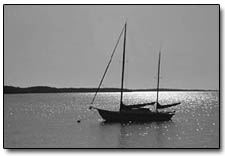
 After
five months, crewing on a yacht called Catmandoo was seeming
less than ideal. A break from my bounce around the ports
of Central America seemed appropriate. After
five months, crewing on a yacht called Catmandoo was seeming
less than ideal. A break from my bounce around the ports
of Central America seemed appropriate.
“Oh, the girls in Columbia are outrageous. Cartagena
will blow your minds in more ways than one. You guys gotta
go,” offered the man I knew only as Byron.
Once a professional ball-player, Byron had given up on
America, bought a cruiser and headed south to the Caribbean.
But, his was no pleasure cruise. Byron was six years deep
into a growing case of cancer, determined to nurse himself
back to health on Caribbean waters and Columbian medicinals.
Appealing though they were, Byron’s tales never
got us to Columbia. Instead of a smooth passage to a promised
land, we sailed directly into surging seas and heavy winds,
a preview of the approaching hurricane season. Under motor
with sails raised only for stability, we beat directly
into the gale for a day and deep into a starless night.
Something had to snap, and fortunately it was the Catmandoo.
Dreams of Cartagena were dashed by a cracked boom and
tattered mainsail. Our integrity as sailors ruined for
all time, we rolled back to where the ill-fated passage
began, the Rio Dulce in Guatemala.
Byron chuckled through yellowed teeth as we pulled back
into the berth we’d left just three days earlier.
“Smooth sailing gentlemen?” he yucked, having
apparently not left his seat at the bar.
Soon, we too were back in our old stools at Susanna’s
Marina, sanctuary for the motor-cruiser, permanent resting
place for a host of disenfranchised ex-pats and one of
the best stocked bars in Central America. Bottles of Flor
de CaF1a rum were beginning to disappear too quickly,
and I was spending far too much time with Byron. Once
amusing, his stories of ingenious contraband trafficking
in Morocco and Thailand were becoming commonplace. It
was time to step off Catmandoo for the last time.
Byron waved “adios” over a fresh glass of
Flor de CaF1a. I muttered a quick “hasta”
and promptly hauled ass for the nearest bus stop and a
trip overland to Honduras.
With that broken boom and those empty bottles floating
in my mind, I happily kicked off my sea legs, settled
into a tight seat in a Guatemalan microbus and made a
strict pact to sever my ties with boats. I would never
work on the sea again. With relief, I turned my back to
the ocean.
Years later, a woman I knew only as Jennifer would warn
me: “Have no illusions about this. It’s going
to be hard and dangerous. The work and the ocean will
do their best to weed you out.”
Jennifer owns a small commercial salmon fishing operation
in Alaska on virtually deserted Kalgin Island. Contrary
to my earlier decision, I’d signed up for another
six-month date with the sea, and I would be running a
skiff and hauling net. The Rio Dulce was but a distant
memory.
Many consider set-netting for salmon hardship embodied.
It is a most basic Alaskan art. Nets teeming with salmon
must be hauled by hand. Wooden boats and fragile nets
make for constant mending. Life becomes a constant communion
with water.
Luckily, there was no hint of the Rio Dulce’s decay
in Jennifer, none of Byron’s debauchery in her ropy
arms or vigor. There was no Flor de CaF1a, no haze of
disenfranchisement and no yachts belching exhaust into
the sea surrounding Kalgin Island.
Rather, there was purity, an honesty born from a farmer’s
relationship with the soil. And, Jennifer was among the
most competent farmers. She had worked the same sites
on the same stretch of coastline for the last 15 years
and embodied that place and that ocean. My brief stint
gave me a snapshot of that relationship.
Throughout that half a year, we relentlessly worked that
watery farm, blanketed by the shadows of Mount Redoubt
and Spur, two 14,00- foot active volcanoes rising directly
from the water. We hauled line during 14-hour Alaskan
days. We came to understand our dependence on the ocean
and stared into its depths with hope and respect.
And, though I hungered for land, I left Kalgin Island
satisfied and cleansed. There was a powerful lesson learned,
an appreciation renewed. Work with the tides, ride the
currents and respect the winds.
Not long ago, one of my fellow crew members from Catmandoo
returned to the states. The boat was now in Venezuela
and no better for the trip.
Apparently, Byron had died a year after he bid me adios.
Tanked on rum, he tripped on the deck of his boat and
plunged to the bottom of Rio Dulce, never to be seen again.
On the up side, he did note that Byron’s mustache
was graying and he was dropping weight at an alarming
rate. Maybe it was his time.
Jennifer stopped in on me a couple months ago, and let
me know she’s still making it on Kalgin Island,
fighting a dwindling run of salmon and plummeting prices.
But Jennifer was never in it for the money. She lives
for the harvest, and she lives for Kalgin Island. Her
way was always driven by a unique relationship with and
respect for that stretch of water.
– Will Sands
|

